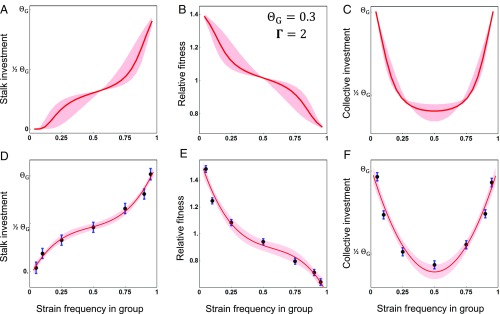Fig. 4.
Patterns of stalk investment, relative fitness, and collective investment as a function of strain frequencies in chimeric aggregations. A–C illustrate expected patterns under parameter values that resemble the empirical results [using the same equations (Eqs. 11–13) to calculate model expectations as those used for empirical estimation], with the bold line corresponding to the case where = 0.3, Γ = 2, and σ = 0.50, with the shading spanning a range of error in measurement of frequency (relatedness) (σ = 0.25 to σ = 0.75). D–F show empirical results from the set of 34 chimeric pairs (n = 944 total chimeric mixes), with the points representing the means and the bars their SEs, estimated from a mixed model (following the model structure in Materials and Methods, but with frequency as a categorical factor). (D) Individual stalk investment by a focal strain as a function of its frequency in a chimeric aggregation. (E) Relative fitness for a focal strain as a function of its frequency in a chimeric aggregation. (F) Collective investment by chimeras as a function of the frequency of a randomly assigned focal strain to the chimeric aggregation. In D and E the bold curve represents the best-fit estimate from the cubic regression model (here fitted to the estimated means). For F, the curve represents the best-fit estimated from a quadratic regression model (fitted to the estimated means). For all three figures (D–F) the shaded region indicates a one SE interval on either side of the best-fit line. Individual (A and D) and collective (C and F) investment values were rescaled by subtracting from the raw measures, under the assumption that (therefore, the value labeled as corresponds to a value of 0.3 in the figure).

